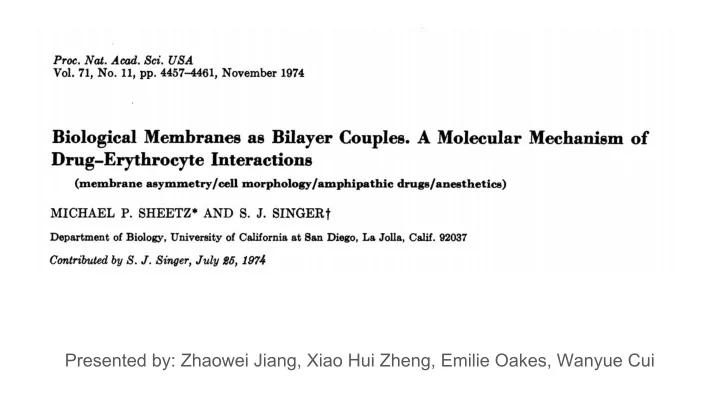

Presented by: Zhaowei Jiang, Xiao Hui Zheng, Emilie Oakes, Wanyue Cui
Background: Fluid Mosaic Membrane The Fluid Mosaic Model of the Structure of Cell Membranes Author(s): S. J. Singer and Garth L. Nicolson Source: Science, New Series, Vol. 175, No. 4023 (Feb. 18, 1972), pp. 720-731
Background: The Bilayer Couple Hypothesis The two halves of the closed membrane bilayer may respond differently to various perturbations while remaining coupled to one another.
Background: Erythrocyte https://www.thoughtco.com/red-blood-cells-373487
Background: Tertiary and Quaternary Amines http://www.ochempal.org/index.php/alphabetical/s-t/tertiary-amine/
Motivation & Goals ● Test bilayer couple hypothesis ● Use this hypothesis to explain the nonspecific noncovalent interaction of a wide range of drugs on the human erythrocyte
Materials & Methods - Reagents
Hemolysis Protection Experiment 1.https://www.ars.usda.gov/northeast-area/docs/safety-health-and-environmental-training/centrifuge-operation/ 2.https://www.indiamart.com/proddetail/uv-vis-spectrophotometer-15379964597.html
Imaging 1.http://laboratorybiologicalmicroscope.wholesale.autoplansearch.com/c1563490-polarized-light-microscopy 2.https://www.jeol.co.jp/en/products/detail/JSM-7610F.html
Scanning Electron Microscopy Substance Critical Critical temperature pressure 373.95 ° C Water 217.7 bar 235 ° C Acetone 46 bar 31.04 ° C CO 2 72.8 bar 1. https://www.pinterest.com/pin/342344009146047159/?lp=true
Observation
Observation Methochlormazine Quaternary amine Crenator Chlormazine Tertiary amine Cup-former
Observation
Conclusion While these new experimental findings, therefore, provide strong additional support for the bilayer-couple mechanism of drug-erythrocyte interactions, they do not prove that each of the many individual elements in the proposal is correct. It would be desirable, for example, to obtain direct evidence about the proposed distributions of different drugs in the two halves of the erythrocyte bilayer by appropriate binding and exchange experiments with right-side-out and inside-out ghosts. A bilayer couple model
Superiority The proposed behavior of molecularly asymmetric membranes as bilayer couples may be significant to many phenomena in cell biology that involve shape changes in a cell or organelle, including cell locomotion and ruffling, microvillus formation, cell-cell and cell-virus fusion, secretion, phagocytosis, and mitochondrial energization.
Scientists could do after this article The possible generality of the proposed bilayer couple mechanism of drug-membrane interactions to other than erythrocyte membranes cannot be dwelt upon here. Whether, for example, an asymmetrical distribution of anionic phospholipids exists in other membranes is not known.
Discussion The author put forward that membranes forming a closed surface, whose proteins and polar lipids are asymmetrically distributed in the two halves of the membrane bilayer, can act as bilayer couples. That is, the two halves can respond differently to a perturbation while remaining coupled to one another.
Thank you Questions?
Recommend
More recommend